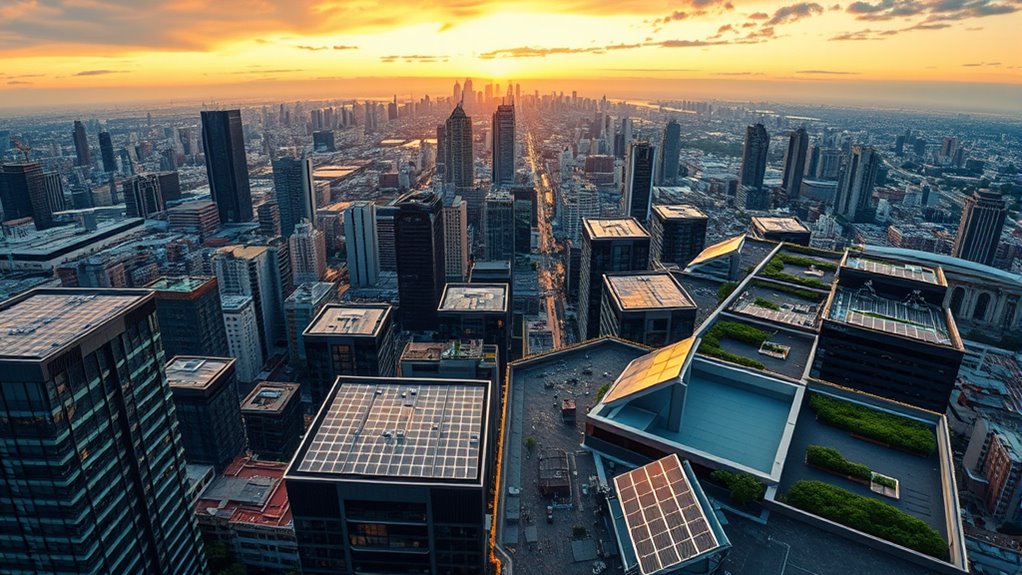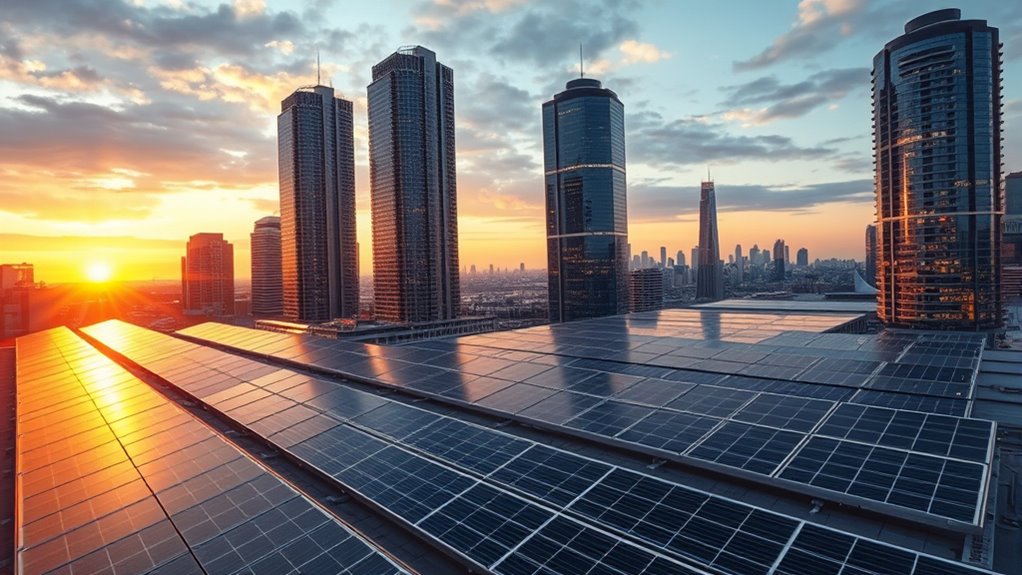By installing rooftop solar panels, you can turn your building into a mini power plant, helping reduce energy bills and carbon footprints. Advances in solar tech make panels flexible, efficient, and easier to incorporate into urban spaces. City policies and incentives are making it simpler to adopt these systems, promoting cleaner air and sustainable growth. If you want to explore how this technology can transform urban environments, there’s more to discover beyond the surface.
Key Takeaways
- High-efficiency, flexible solar panels enable buildings to generate substantial energy while blending seamlessly with architecture.
- Urban policies, incentives, and streamlined permits lower installation barriers, encouraging rooftop solar adoption.
- Integrating solar into city planning promotes sustainable development and maximizes energy harvesting from building surfaces.
- Rooftop solar transforms urban buildings into decentralized power sources, reducing reliance on centralized grids and lowering emissions.
- Innovations in solar technology and policy support turn city rooftops into resilient, clean energy hubs for sustainable urban growth.

As cities grow denser and energy demands increase, rooftop solar offers a practical solution to reduce reliance on fossil fuels. You can harness the sun’s power right over your head, transforming your building into a mini power plant. Recent advances in solar panel innovations make this even more feasible and efficient, especially in urban environments where space is limited. These innovations include high-efficiency photovoltaic cells, flexible panels that contour to irregular surfaces, and aesthetically integrated designs that blend seamlessly with building architecture. Such developments mean you don’t need large, bulky systems to generate substantial energy; even small rooftops can produce meaningful power, helping lower your energy bills and carbon footprint. Additionally, the incorporation of solar technology into building designs further enhances energy capture and overall system performance. Urban energy policies play a critical role in encouraging rooftop solar adoption. Many cities now offer incentives like tax credits, rebates, or streamlined permitting processes to make installing solar panels more accessible and affordable. By aligning policies with technological advancements, local governments aim to remove barriers and promote sustainable urban growth. As a city resident or property owner, you benefit from these policies because they reduce upfront costs and simplify the installation process. In some places, regulations have been adapted to allow for shared solar arrangements or net metering, enabling you to sell excess power back to the grid. This not only offsets your costs but also contributes to a more resilient and distributed energy system. The combination of solar panel innovations and progressive urban energy policies creates a compelling case for rooftop solar in cities. You’re empowered to take advantage of new technologies that maximize energy capture even in shaded or partially sunny areas, making solar viable in densely built neighborhoods. Moreover, urban planning strategies can facilitate the integration of solar infrastructure into city landscapes, further supporting adoption. Local policies that support community solar projects or provide clear guidelines for rooftop installations further streamline your path to clean energy. As a result, you can contribute to reducing citywide emissions, improve local air quality, and foster a more sustainable urban environment. The shift toward rooftop solar isn’t just a trend; it’s a strategic move toward energy independence in cities. It allows you to turn your building into a clean energy resource, demonstrating how technological progress and forward-thinking policies can work together to reshape urban energy landscapes.
Frequently Asked Questions
How Do Rooftop Solar Panels Affect Building Aesthetics?
You might notice that rooftop solar panels can influence a building’s aesthetics by affecting its architectural harmony and visual impact. While some see them as modern enhancements, others feel they may disrupt the building’s original design. Depending on the placement and design, solar panels can either blend seamlessly or stand out prominently. Ultimately, thoughtful integration helps balance functionality with visual appeal, ensuring the building remains attractive while generating clean energy.
What Incentives Are Available for Urban Solar Installations?
Did you know that over 40 states in the U.S. offer incentives for solar? You can take advantage of government grants and tax credits that markedly reduce installation costs. These incentives aim to make urban solar more affordable and accessible, encouraging more people to turn rooftops into power sources. By exploring these options, you can save money and contribute to a cleaner, greener city environment.
How Is Rooftop Solar Integrated With City Infrastructure?
You can see how rooftop solar integrates with city infrastructure through urban grid integration, which connects solar systems to the local grid, allowing seamless energy flow. Solar policy regulations support this by setting standards for safety and efficiency, encouraging adoption. These policies help coordinate solar installations with existing infrastructure, ensuring reliable energy distribution and maximizing the benefits of urban solar power, making cities more sustainable and resilient.
What Are the Maintenance Requirements for Urban Solar Panels?
You need to regularly maintain your urban solar panels by performing panel cleaning to remove dust, debris, and bird droppings that can reduce efficiency. Additionally, inverter upkeep is essential; check for any error messages and ensure proper cooling. Schedule inspections at least once a year, and keep an eye on system performance. Proper maintenance maximizes energy production and prolongs your solar system’s lifespan in the city environment.
How Do Rooftop Solar Systems Impact Property Values?
You’ll find that rooftop solar systems boost property values, attract buyers, and improve property appraisal scores. They enhance energy efficiency, lower utility bills, and demonstrate sustainability efforts. When considering solar panel financing, these installations become an investment, increasing your property’s appeal. You can confidently expect that adding solar panels elevates your property’s marketability, making it more attractive to eco-conscious buyers and positively influencing your property appraisal.
Conclusion
Imagine your city skyline shimmering with rooftops turned into tiny power plants, each one like a shining gem powering neighborhoods. When you embrace rooftop solar, you’re not just saving money—you’re fueling a movement that transforms dull buildings into vibrant energy hubs. Think of it as planting a garden on every rooftop, turning concrete jungles into lush, sustainable landscapes. Together, we can light up our cities with clean, renewable energy—one rooftop at a time.









